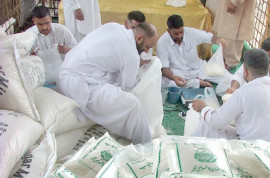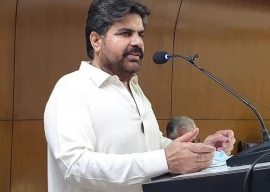
In a budget that appeared to reflect no major changes, Sindh Finance Minister Murad Ali Shah presented the provincial government’s proposed Rs739 billion budget, with only marginal increases in regular expenditures and an actual cut in the development budget. Sindh is also likely to be the only province that will run a budget deficit.
The single biggest allocation in the Sindh budget, as with all provinces, was towards education. “The government of Sindh attaches the utmost priority to education,” said Shah, in his speech on the floor of the Sindh Assembly in Karachi on Saturday. The total allocation for education will be Rs153 billion for fiscal 2016, up by 7.2% compared to the outgoing year. However, education only accounts for 21.2% of the Sindh budget, compared to 27% of the Punjab budget. Of that amount, Rs13.2 billion is for the education development budget, up from Rs11 billion in fiscal 2015.
“For better management of schools, 1,484 posts have been created in the education department which include 1,300 posts for headmasters/headmistresses,” said Shah, adding that Rs200 million has been earmarked to eliminate ghost schools and teachers with an effective monitoring system.

The budget also contained several populist measures focused mostly on expanding the public sector, such as adding 14,480 government jobs, increasing the minimum wage to Rs13,000 a month from Rs12,000 a month (in line with federal standards), increasing government employee salaries by 10%, and their medical allowances by 25%, as well as merging all ad hoc increases up to fiscal 2012 into the permanent salary structure. Government employee pensions were also increased to Rs12,000 per month.
Any Sindh government employees with doctoral degrees will now get an allowance of Rs10,000 per month, which will replace the science and technology allowance of Rs7,500 a month and the PhD allowance of Rs2,250 per month. The increases in public sector employment will cost the Sindh government Rs9 billion in fiscal 2016.

The government will also target providing 100,000 young people training in vocational skills under the Benazir Bhutto Shaheed Youth Development Programme.
The overall budget is 7.7% higher than last year’s Rs686 billion, and is project to have a Rs12.7 billion deficit.
Sindh’s development budget of Rs162 billion will be Rs6 billion, or 3.6%, smaller that the outgoing fiscal year. The total value of development projects currently in progress in the province is estimated at Rs213 billion. Of that amount, Rs177 billion (83%) comes from the provincial development budget, Rs26 billion through foreign aid, and Rs9 billion through federal aid.
The second biggest allocation from the Sindh budget will go towards law enforcement, which will get Rs65 billion, or 8.8% of the total. Of that amount, Rs61 billion will go to the Sindh police, Rs2.4 billion to the Rangers and Rs1.5 billion to the Frontier Constabulary. The government will add 10,030 new personnel to the Sindh police force.
For current expenditures in health, the government has allocated Rs54 billion for fiscal 2016, up nearly 26% compared to the outgoing year. For energy, the provincial government has earmarked Rs16.5 billion, including money for the government’s commitment to its coal, wind and other energy project.
The Sindh government has also allocated significant funds for its city governments, including Rs49 billion in development projects for Karachi, an increase of 48.5% compared to the outgoing year.
“To fulfill the needs of Karachi, the Karachi mass transit project with the circular railway, five bus rapid transit lines and two metro rail transit lines have been planned,” Shah said, adding that government is fully committed for the revival of the Karachi circular railways with the assistance of Japanese International Cooperation Agency (JICA).
The provincial government has also allocated development budgets for other urban centres, including Rs37 billion for Hyderabad, Rs19 billion for Sukkur, Rs33 billion for Larkana, Rs36 billion for Mirpurkhas, and Rs17 billion for Nawabshah.
Fiscal measures
While most of the province’s revenues will come in the form of transfers from the federal government, Sindh will take some actions regarding its own taxation regime, mostly reducing taxes on many categories. Shah said that the government will try to improve the revenue collection performance of the Sindh Revenue Board, which has been set a services sales tax (SST) collection target of Rs61 billion for fiscal 2016. To achieve that target, some sectors currently exempt from the SST will be brought into the tax net. “Travel agents, credit rating agencies, copyright for intellectual property, auctioneers, commission agents, renting of commercial property will come under the tax net,” he said.
Meanwhile, to encourage compliance from sectors that are already paying their taxes, the rates will be reduced. “The SST rate will be reduced from 15% to 14%,” said Shah, adding that the tax on the telecommunications sector will be reduced from 19.5% to 18%. “Education and medical services and advertisements in newspapers will also be exempted from the SST,” he said.
Published in The Express Tribune, June 14th, 2015.


















COMMENTS
Comments are moderated and generally will be posted if they are on-topic and not abusive.
For more information, please see our Comments FAQ